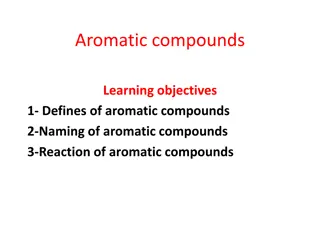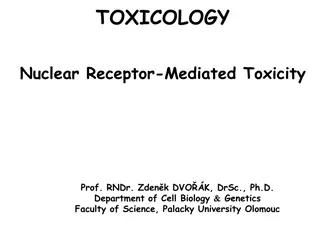Aromatic compounds
Aromatic compounds are chemical compounds containing a ring with delocalized pi electrons. Learn about the definition, naming conventions, and reactions of aromatic compounds such as benzene. Explore topics like aryl groups, halogenation reactions, and the mechanism for bromination of benzene.
0 views • 19 slides
Transition Metals Organometallic Compounds Overview
Transition metals bonded with organometallic compounds like metal alkyls, aryls, and hydrides are common in chemistry. Ligands are crucial for stabilizing these complexes, with carbon-based ligands exhibiting diverse binding modes based on the metal's hybridization state. Preparation methods for tra
1 views • 25 slides
Ligands and Metal Carbonyl Complexes: A Comprehensive Overview
Explore the classification of ligands in metal complexes, including alkyl, aryl, and carbonyl ligands. Learn about the unique properties of carbonyl ligands, their preparation methods, and the molecular orbital diagram illustrating CO-metal bonding interactions.
5 views • 35 slides
Update on Malaria Libre Project Meeting - 19th April 2023
The Malaria Libre Project Meeting held on 19th April 2023 discussed key topics such as the Aryl Imidazole chemical series, potential new series, and the MMV Early Lead Criteria for the next milestone. Chemistry resources appointed by MMV were also outlined, focusing on Aryl Imidazoles as the main ar
0 views • 13 slides
Chemistry and Medicinal Uses of Pyrazole & Imidazole
Explore the chemistry, synthesis, reactions, and medicinal applications of pyrazole and imidazole compounds in pharmaceutical organic chemistry. Dive deeper into the molecular structures and understand the significance of these compounds in drug development and therapy.
1 views • 20 slides
Dakin Rearrangement in Organic Chemistry: Mechanism and Positional Effects
The Dakin Rearrangement, also known as Dakin oxidation, is an organic redox reaction involving hydroxylated phenyl aldehydes or ketones reacting with hydrogen peroxide to form benzenediols and carboxylates. The mechanism includes nucleophilic addition, [1,2]-aryl migration, and final product formati
1 views • 9 slides
Exploring the Fascinating World of Grignard Reagent in Organometallic Chemistry
Delve into the significance of the Grignard Reagent, a pivotal discovery honored with the Nobel Prize in Chemistry in 1912 for its transformative impact on organic chemistry. Unveil the versatile applications and reactions of this essential reagent, showcasing its ability to react with various subst
0 views • 42 slides
Understanding Aldehydes and Ketones in Organic Chemistry
Aldehydes and ketones are compounds that contain carbonyl groups (>C=O). Aldehydes have the CO group linked to either two hydrogen atoms or one hydrogen atom and one alkyl or aryl group, while ketones have the CO group linked to two alkyl or aryl groups. The structure of the carbonyl group is charac
0 views • 26 slides
Understanding the Redox-Relay Heck Reaction in Organic Synthesis
The Redox-Relay Heck Reaction is a powerful tool in organic synthesis that allows for the functionalization of olefins with aryl groups. Developed by Sigman and colleagues, this reaction involves a palladium-catalyzed relay controlled by a thermodynamic sink, leading to the formation of aldehydes or
0 views • 6 slides
Understanding Amines: Structure, Properties, and Uses
Amines are derivatives of ammonia with alkyl or aryl groups replacing hydrogen atoms, making them more basic due to the presence of an unshared electron pair on the nitrogen atom. This summary covers the order of basicity, key compounds like Ethylene Diamine and Amphetamine, as well as their structu
0 views • 4 slides
Nuclear Receptor-Mediated Toxicity: Molecular Insights and Implications
TOXICOLOGY research on Nuclear Receptor-Mediated Toxicity by Prof. Zdeněk Dvořák delves into the evidence, molecular properties, structures, and signaling pathways of nuclear receptors such as Aryl Hydrocarbon Receptor (AhR). Detailed information on the impact of AhR-mediated toxicity, including
0 views • 19 slides










